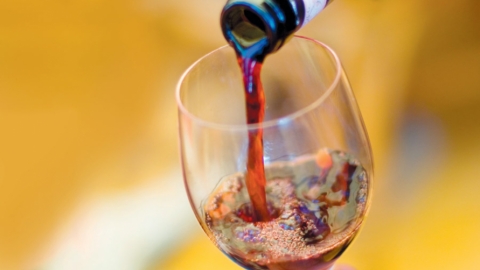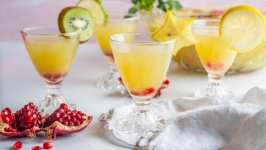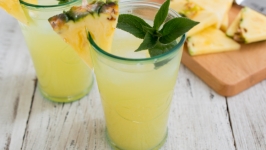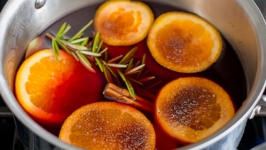Aging to Perfection: Tasting History of the Region
Deep roots and a history of innovation endure in South Bay’s winemaking hills and valleys
The historic Novitiate Winery, carved into the hills above Los Gatos, is a study in contrasts. Built in 1888, it is the state’s fourth-oldest continuously operating winery. It still uses its original, and decidedly low-tech, gravity-flow production. But today, Novitiate is the home of Testarossa Winery, and in its caves you’ll find 21st-century technology—such as a “smart fog” system that increases humidity to lessen evaporation from the wine barrels, reverse osmosis water purification, a state-of-the-art destemmer and more.
Testarossa is one example of the complex marriage of tradition and technology that defines the wine industry in the Valley and surrounding hills. Founded and run by former Silicon Valley engineers Diana and Rob Jensen, the husband and wife team bring a mind-set to wine that they learned in their high-tech careers.
“Testarossa is a product of Silicon Valley,” says Rob Jensen. “We have that same mentality, and we’re constantly reinventing ourselves. For example, each year our director of winemaking, Bill Brosseau, asks every one of his 18-member team to submit an idea to improve the winemaking process. We’re actively encouraging the mind-set of innovation.”
A Start-up with European Roots
The Franciscan monks first brought viticulture to the Santa Clara Valley, producing their first vintage at Mission Santa Clara in 1802. But it was the Gold Rush of 1849 that triggered Northern California’s rapid wine country development. The boom attracted a flood of French, Italian and German pioneers thirsty for the wines they enjoyed at home. Between 1880 and 1885, these wine-drinking immigrants planted thousands of vineyard acres in Santa Clara Valley. Blessed with a Mediterranean growing climate, these vineyards—and wines—thrived.
French émigré Etienne Thée planted the New Almaden vineyards at the foot of the Santa Cruz Mountains in 1852. Sons-in-law Paul Masson and Charles LeFranc grafted Old-World cuttings onto this American rootstock, successfully producing fine still wines. Masson eventually took over management of the winery and in 1892 began making California sparkling wine. In 1905 the “Champagne King of California” built his own winery in the Mt. Eden district of Saratoga in the Santa Cruz Mountains, now the site of the Mountain Winery, known today for its star-studded concerts and panoramic views of Silicon Valley.
During that growth period, Northern California vintners sent most of their wine to San Francisco, the hub of the region’s wine business. At the turn of the century, bottling, storing and distributing all took place in the city and the new California Wine Association was founded, which quickly asserted a near-monopolistic control over the industry.
From Bounty to Bust
If the late 1800s were the industry’s boom years, the next four decades were filled with catastrophes. An outbreak of phylloxera in the Valley wiped out its best and most abundant vine, Vitis vinifera (see sidebar). The 1906 San Francisco earthquake destroyed an estimated 20 million gallons of wine stored in warehouses and cellars. Prohibition (see pg. 28) was the third strike, crippling the relatively young California wine industry.
A Devastating Silicon Valley Bug
Eighty years after European viticulture fell victim to a bug imported from the United States, Northern California vines were in the same sorrowful situation.
Phylloxera, a tiny sap-sucking insect similar to an aphid, feeds on the roots and leaves of one type of wine grape—Vitis vinifera—weakening and killing the vines. When botanists brought non-native vine cuttings from America to Europe in the mid-1800s, phylloxera came, too. The infestation spread widely and by the 1900s, an estimated 80% of all European vineyards were destroyed.
Because the quality of wine produced from native American grapes was inferior to that of French wines, early American viticulturists routinely planted nothing but European vines. In so doing, they were creating a new habitat for the hungry bugs. By 1883, Santa Clara Valley grape growers had phylloxera-infected vineyards.
A French pharmacist, Jules-Émile Planchon, and an American entomologist, Charles Riley, identified the culprit nine years earlier. Scientific research to solve the problem included hybridization—breeding resistant species with Vitis vinifera—and grafting Vitis vinifera onto resistant rootstock. Eventually, European growers adopted the grafting technique and replanted their vineyards with phylloxera-resistant American rootstock.
During the 1960s and ’70s viticulturists throughout Northern California planted AxR #1, a hybrid rootstock recommended by UC Davis. Unfortunately, the hybrid succumbed to a new phylloxera mutation in the early 1980s and vineyards with the hybrid had to be replanted on grafted rootstock. The cost of debugging California’s vineyards? About $1 billion.
Access Denied: The Prohibition Years
The 18th Amendment, also known as the “Noble Experiment,” banned “the manufacture, sale and transportation of intoxicating liquors.” The law went into effect on January 16, 1920, lasted for 13 long, dry years and severely impacted the fledgling California wine industry. Farmers ripped out acres of premium vineyards and planted fruit trees.
Wines didn’t completely disappear, however. Along with illegal bootlegging, wine producers were helped by two legal loopholes. First, medicinal and sacramental wines were allowed. This helped the Novitiate Winery, established by Jesuit priests in Los Gatos in 1888, to survive Prohibition. In fact, the demand for sacramental wines was so great that the winery and vineyards more than doubled in size during this time.
Second, every family was legally allowed to produce 200 gallons of wine for family consumption, which created an enormous demand for grapes for the home market. Instead of producing wines, the wine industry began shipping California grapes and juice concentrate back East. Local viticulture continued, but delicate premium varieties, such as Cabernet and Pinot Noir, were replaced with varieties such as Alicante Bouschet. Although its taste was far inferior, it produced big yields, with lots of color and tough skins that could withstand a long, unrefrigerated boxcar trip to East Coast urban centers.
Prohibition ultimately took its toll on the industry. By 1933, three quarters of California wineries had closed and quality winemaking would take years to recover.
A Wine Industry Disruptor
When Prohibition ended, a maverick winemaker, Martin Ray, purchased the Paul Masson Champagne Company, setting the stage for a huge market shift. Rather than making blended wines from inferior grapes, the common practice, Ray started bottling 100% single-varietal wines from high-quality fruit. In 1943, Ray bought a plot of land 2,000 feet above the valley and established the first vineyards in what would become the Santa Cruz Mountain AVA, with plantings of Pinot Noir and Chardonnay.
Today, Ray’s mountaintop vineyard in Saratoga is the home of Mount Eden Winery, where grower and winemaker Jeffrey Patterson continues Martin Ray’s legacy. Patterson says that he doesn’t use technology in his hands-on style of production, though Silicon Valley has influenced the winery in a different way. “The Santa Cruz Mountains AVA is off the beaten path—we’re no Napa. It’s the quality of our vineyards and the resulting wines that have brought us international acclaim. We have no tasting room at Mount Eden and depend on wholesale business. Still, our proximity to an affluent, knowledgeable market that appreciates this level of quality has had an impact.”
A Shift from Vines to Silicon
The late 1950s and early 1960s marked the explosive growth of the technology industry and Santa Clara Valley property values skyrocketed with market demand. Farmers sold their land to developers and, almost overnight, the “Valley of Heart’s Delight” was transformed into industrial parks, shopping centers and housing divisions that became the hallmark of Silicon Valley. Vineyards persisted where property values were lower: in the southern Santa Clara Valley and Santa Cruz Mountains. The wineries that survived were now the beneficiaries of a newly moneyed tech industry, and started to profit from an educated local clientele with a taste––and a budget––for fine wines.
In the 1970s, local wineries transformed their operations to meet the new demand for premium wines. George Guglielmo, son of a third-generation winemaker in Morgan Hill, convinced his father to begin bottling single varietals, elevating the family winery from cheap jug wine to premium wine production. Today, George and his brothers Gene and Gary own and operate Guglielmo Winery, which was founded in 1925 and is the oldest continuously operated family winery in Santa Clara Valley.
“Tastes changed and we changed with them,” says George. “We’ve grown and diversified our business, all while retaining our family culture and tradition of making the best wine to share with family and friends.”
Balancing the Art and Science of Wine
Perhaps the most significant moment in Silicon Valley’s wine history took place nearly 6,000 miles away, on the banks of the Seine. The Paris Tasting of 1976, also known as the Judgment of Paris, pitted relatively unknown California wines against well-established French houses in a blind tasting. Ridge Vineyards, a then 14-yearold Cupertino winery in the Santa Cruz Mountains, finished fifth in the reds competition with their 1971 Monte Bello blend. The competition put California on the global wine map, even though European judges were still skeptical of the wines’ aging potential. In 2006, a 30th anniversary re-tasting was organized to compare the wines again. This time, the ’71 Ridge Monte Bello took first place.
Paul Draper is the winemaker and the driving force behind the distinctive Ridge Monte Bello, a Cabernet blend made from vineyards carved out of a hillside ridge, 2,600 feet above the valley. Draper joined Ridge Vineyards in 1969, a decade after four Stanford Research Institute scientists purchased the land, and made the first quarter barrel of Cabernet. It was so distinctive it prompted the move to commercial production.
“I like to call our winemaking technique ‘pre-industrial,’” says Draper, referring to the post-Prohibition wine programs started at universities that began to teach winemaking as an “industrial process” to give wineries the ability produce commercially acceptable wines year after year. Draper feels this factory approach started to produce wines “lacking a sense of place and complexity” and without the ability to age properly. “Focusing on quality, we use traditional techniques at Ridge, with minimal intervention in both growing and production.”
Monte Bello’s current winemaker, Eric Baugher—ironically a chemist—echoes Draper’s sentiments. “Quality begins in the vineyard. It’s all about nature––we use organic viticulture and try to stay out of the way. So, it’s really ‘low-tech’ winemaking. We’re in it because we’re artists.” Although Ridge may have the best analytics lab of any winery its size, he says that science and technology are put to work not to improve their “grape-to-wine” process, but to ensure the wine’s quality and stability.
Silicon Valley wine is a perfect blend of technology, exceptional terroir, appreciative customers and a rich viticultural history. Says Baugher, “We’re in a good spot—literally and figuratively.”







